How to choose and use manual riveters?

The riveter, also known as the riveter, is a tool designed to fasten structural elements with rivets. The advantage of just such a connection is its vibration resistance and low cost. For a long time, the installation of rivets remained a purely industrial operation, used mainly for the manufacture of large structures or structures (steel bridges, cladding of ocean-going ships, mounting armor plates, etc.). It is not out of place to mention the well-known Eiffel Tower, the whole structure of which is held in place thanks to rivets. It became possible to connect small sheet metal parts, and even in the conditions of a home workshop or garage, after the invention of the manual riveter.

Description and working principle
The device of all types of rivets is similar, only the drive of the tool (electric, pneumatic or mechanical) can be different. The manual riveter is no exception. GThe main principle of the tool is the connection with a hollow rivet of structural elements by crushing one end of it.
According to GOST, rivets are of several standard types, differing in diameter and length. For a high-quality connection, the combination of the length and diameter of the consumable is important, of course, the larger the diameter, the thicker the sleeve wall and, accordingly, the more reliable the connection. Length is just as important, it determines how thick materials can be joined.
The manual riveter works as follows: through the rivet inserted into the hole using a system of levers, pressing the handles, we pull a steel pin with a thickening at the end. This expands the hollow rivet tube and holds the material together. The remainder of the pin breaks off.

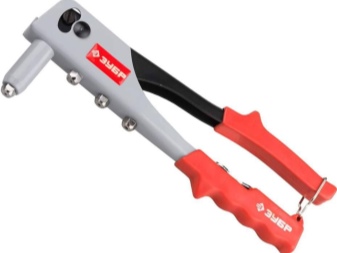
Sometimes, with a large rivet length and diameter, a sufficiently large force is required; for this, the manual riveter is equipped with long handles and a system of levers that allow to distribute the force. If the material of the tool itself is not strong enough, loads can lead to wear, and repair is not always possible. Since different companies produce far from the same riveting tools, finding suitable spare parts can be more expensive than purchasing a new tool.
The most common type of hand-held blind riveter, called "pistol", is quite simple. It has two handles. One is movable, transmitting force to the mechanism, the second is fixedly connected to the tool body. It is to it that the elements of the ratchet mechanism are attached, stretching and breaking off the rivet pin, into it, with the help of a thread, heads are installed under the corresponding diameter of the rivet pin.

Species overview
The development of manual mechanical riveters went in several main directions, the general requirement was to apply physical efforts to the power mechanism to form a strong connection.

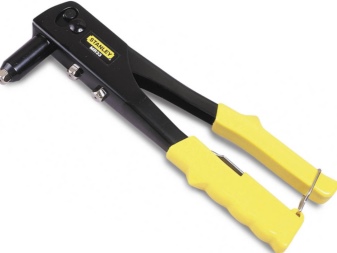


By the type of rivets used
The evolution of rivets paralleled the evolution of rivets, which led to the emergence of fundamentally different tools. Traditionally, rivets are made from steel, copper or aluminum. The use of different metals requires different efforts and different designs of rivets.Joining with simple copper or aluminum rivets could be made with a hammer, and the same could be done with steel rivets. However, in the conditions of a home workshop or garage, such a seemingly simple operation often turned out to be almost impracticable.
Another thing is the use of steel blind rivets. For blind rivets, a manual mechanical riveter is sufficient. The development of a lever-ratchet mechanism made it possible to develop a tool for steel rivets. The tool for threaded rivets is slightly different. Working with such a device, in contrast to pulling rivets, takes more time, however, the connection is more durable.
Typically, threaded rivets are used to connect thicker parts that are subject to significant stress.

By the number of handles
Manual riveters were divided into the so-called two-handed and one-handed, depending on how many hands are involved in the operation. The two-handed riveter produces a very significant force. Such a tool can be used for long-term work, since it distributes the load quite evenly, and thanks to the long handles and lever mechanism, it allows relatively little physical effort to be dispensed with. Some models for installing hollow rivets are equipped with a special container for collecting broken pins, which is especially important for industrial work. However, this type of tool also has a drawback, with its help you can only work by providing free access to the junction.
This problem can be solved with a one-hand riveting machine - the so-called "pistol". The force on the ratchet is transmitted from one hand by compressing the movable and fixed handles. When installing thin and short rivets, one movement is enough, however, more often you still have to do several squeezes of the handles before the rivet rolls over and the pin breaks off. Such a tool can be used to install a small number of rivets, since the length of the handles still requires quite a lot of physical effort.


However, the small size allows the use of a one-handed tool where it is impossible to place a two-handed one. Besides, some models are equipped with a swivel head, which greatly expands the range of their application. Most of the models have a reinforced body fixedly connected to one of the handles, which allows the tool to be used successfully for many years. Professionals have in their arsenal both two-handed and one-handed tools that allow them to quickly and efficiently rivet any parts and materials.
A separate species is the "accordion" riveter, aka "frog". It can also be classified as one-handed instrument. The force on the mechanism is transmitted from the compressible linkage system. With the help of such a riveting machine, large diameter rivets can be used quite effectively.
The main disadvantage of the "frog" is the need to provide free access to the junction due to its relatively large dimensions.

Rating of the best manufacturers
Hand riveters are produced by almost all companies, one way or another related to the production of hand tools. Among them there are some kind of leaders, whose products are deservedly in high demand or have the greatest number of positive reviews. Let's start with one-handed models.
A relatively inexpensive representative of this class from the German company Stayer can be successfully used at the household level. Interchangeable heads allow the installation of 2.4 mm, 3.2 mm, 4 mm and 8 mm blind rivets. The more expensive version from the same manufacturer is equipped with a swivel head and can be used to work in a wide variety of conditions.
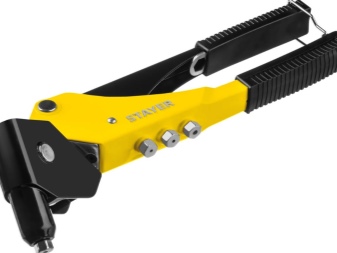

A similar tool POP PS-15 is produced in the UK, made of an aluminum-based alloy, which makes the tool one of the lightest in its class (no more than 600 g). The riveter is equipped with three removable heads for different diameters of consumables. Comfortable handles allow you to work for a long time. Experts recommend such a tool for professionals because of its exceptional reliability.


Russian-Chinese manufacturer of tools "Zubr" also presents to the market the successful model "Bison Master-31195". The model is equipped with a swivel head and four replaceable nozzles of different diameters. The aluminum alloy provides a weight of about 700 g. Comfortable handles allow you to work for a long time. Another model of this manufacturer "Zubr Universal 270 mm" has 8 attachments for different rivet diameters in the set. This greatly expands the range of its use.

The swivel head has an Italian armero zepper with the A320 / 104 marking. The diameter of the blind rivets varies from 3 to 5 mm. Light weight and durable alloy, according to experts, cannot compensate for the inconvenience of plastic handles. However, everything pays off with reliability and the ability to work in a variety of conditions.

The reliable one-hand riveter for threaded rivets is offered by the Russian manufacturer Cobalt. The tool under the name "Cobalt 243-561" has a light weight, a durable aluminum body, very comfortable handles. The diameter of the rivets is limited from 4 to 6 mm. The product range of this manufacturer also includes rivets for blind rivets, both one-handed and two-handed.

Popular two-handed models usually represent the same manufacturers. The two-handed riveter from the already mentioned Stayer company can be classified as a professional tool. The two-handed scheme allows you to work with it for several hours, having installed hundreds of rivets during this time.

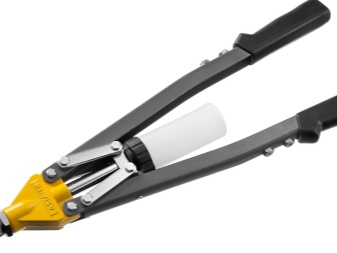
Akin to the previous and no less popular German model Kraftool industrie 31182, has long foldable handles that allow for significant force when installing the blind rivet. When folded, the tool fits into a compact case, in which removable nozzles for various rivet diameters are placed. Experts note the significant weight of this professional tool, about 3 kg. But this is also indicated as a guarantee of the highest reliability of this model.

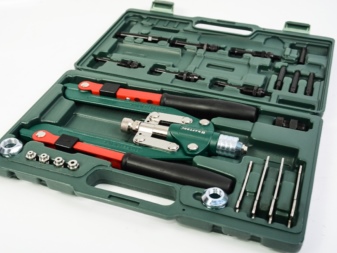
How to choose?
When choosing a riveting machine, one should be guided by the tasks that it is supposed to solve with its help. If the tool will be used to install hundreds of rivets per shift, it is better to opt for a two-handed model, it is desirable that the handles are solid, not folding. This is the most robust scheme. It is also a good idea to have a tool box for broken pins, this will keep the work area tidy after installing a large number of rivets.
The choice of a tool for the home is more democratic. In this case, one of the main criteria should be reliability and convenience. If you plan to install several rivets sometimes, it makes no sense to buy a professional two-handed tool. For workshops, it is better to have a set of rivets. Two-handed for basic work and, just in case, one-handed with a swivel head. If you have to work with rivets professionally, it is better not to save money and buy tools from trusted manufacturers.
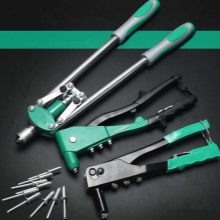


How to use?
The procedure for all riveters is approximately the same. Step-by-step instructions for working with any blind rivet can fit in three lines.
- Drill a hole in the elements to be fastened.
- "Load" a rivet of the appropriate size.
- Pull the steel pin and break it off.
As a result, you should get a reliable one-piece connection of parts.If the diameter of the rivet turns out to be significantly less than the diameter of the hole, fastening may not take place. If the rivet is too long, the connection may be loose. Therefore, it is important to correctly determine the thickness of the drill in order to drill the mounting hole. Maybe a millimeter thicker than the rivet. The length of the consumable must exceed the total thickness of the fastened elements by at least 1 cm.
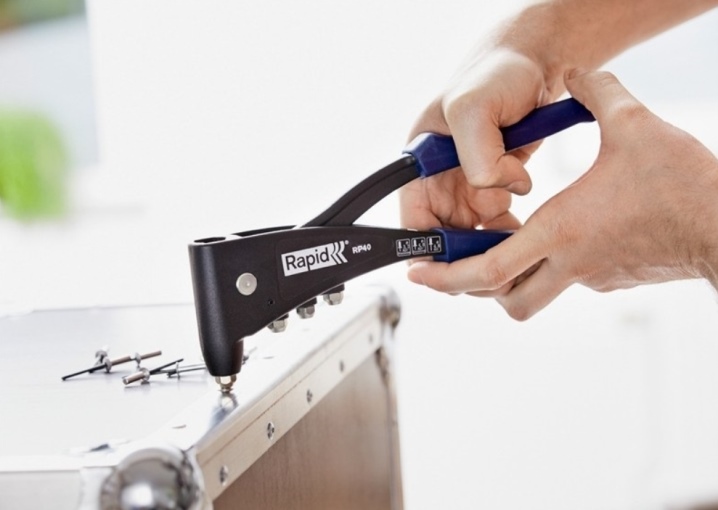
Working with threaded rivets is slightly different.
- The consumable is screwed onto the rivet tip.
- In the screwed position, the rivet is inserted into the mounting hole.
- By pressing the handles of the rivet, the tip is pulled out, this leads to the creasing of the rivet.
- The tip is screwed down from the rivet.
- For reliability, a bolt corresponding to the thread pitch is screwed into the rivet, if necessary, the connection can be strengthened by screwing a nut onto the bolt.
As you can see, working with threaded material takes a little longer, but the connection is more durable.



Possible malfunctions
Riveter malfunctions are usually associated with the most vulnerable part of it - the ratchet mechanism. This is manifested in the fact that the tool does not grasp the rivet pin, pressing the handles does not lead to its pulling, and rolling does not occur. Sometimes, to restore functionality, it is enough to clean the clamping jaws from chips and dirt. In order to repair the tool, you will have to disassemble it, remove the spring and check the condition of the jaws. In special cases, the sponges will need to be replaced.
It is desirable to purchase an original part. Some craftsmen try to make sponges with their own hands, this may make sense if you need to finish the work you have started, and only a few rivets remain. In the future, it is still better to replace homemade elements with original ones.
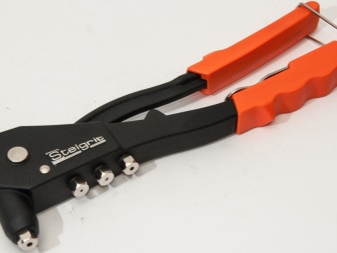

The following video explains how to use the hand riveter correctly.










The comment was sent successfully.